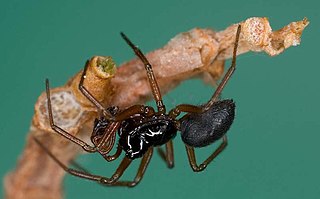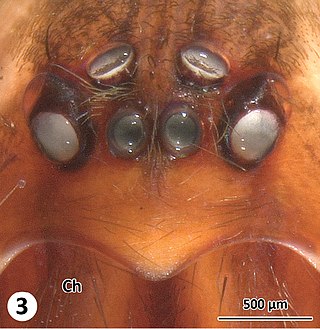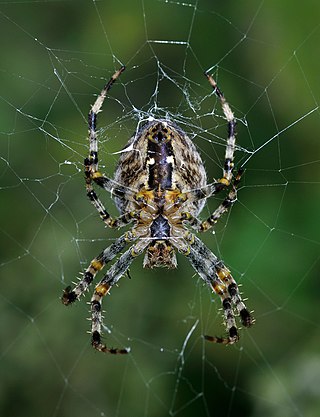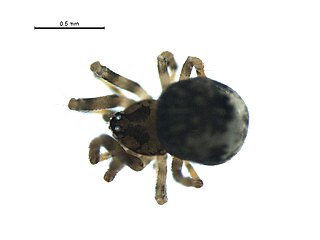
Linyphiidae, spiders commonly known as sheet weavers, or money spiders is a family of very small spiders comprising 4706 described species in 620 genera worldwide. This makes Linyphiidae the second largest family of spiders after the Salticidae. The family is poorly understood due to their small body size and wide distribution; new genera and species are still being discovered throughout the world. The newest such genus is Himalafurca from Nepal, formally described in April 2021 by Tanasevitch. Since it is so difficult to identify such tiny spiders, there are regular changes in taxonomy as species are combined or divided.

Erigoninae are the largest subfamily of sheet weavers (Linyphiidae), which is itself the second largest spider family. In the United States they are known as dwarf spiders, while they are called money spiders in England. The exact taxonomic limits of the subfamily are not yet known.

Lampshade spiders, family Hypochilidae, are among the most primitive of araneomorph spiders. There are two genera and twelve species currently recognized. Like mygalomorphs, most hypochilids have two pairs of book lungs, but like araneomorphs they have intersecting fangs, with the exception of some species which have chelicerae in an angle that is neither orthognathous or labidognathous. These long-legged spiders build typical "lampshade" style webs under overhangs and in caves. In the United States the fauna is primarily associated with the Appalachian, Rocky and California Mountains. Ten of the known species are found in these ranges, all in the genus Hypochilus. The genus Ectatosticta is found in China.

Austrochilidae is a small spider family with nine species in two genera. Austrochilus and Thaida are endemic to the Andean forest of central and southern Chile and adjacent Argentina.

The Entelegynae or entelegynes are a subgroup of araneomorph spiders, the largest of the two main groups into which the araneomorphs were traditionally divided. Females have a genital plate (epigynum) and a "flow through" fertilization system; males have complex palpal bulbs. Molecular phylogenetic studies have supported the monophyly of Entelegynae.

Tetrablemma is a widespread genus of armored spiders first described by Octavius Pickard-Cambridge in 1873. It contains 30 species found in tropical and subtropical regions primarily throughout Asia and Oceania, with one species, Tetrablemma rhinoceros, known from Angola. They are found in leaf litter, soil, and caves.

Macrothele is a genus of mygalomorph spiders in the family Macrothelidae, and was first described by A. Ausserer in 1871. Most of the species in the genus occur in Asia, from India to Japan, and Java, with five found in Africa, and two in Europe. The name is derived from Ancient Greek μακρός ("makro-"), meaning "big", and θηλή ("thele"), referring to the spinnerets.

Coddingtonia is a genus of Asian ray spiders that was first described by J. A. Miller, C. E. Griswold, & C. M. Yin in 2009. It is a senior synonym of Luangnam.

Mysmena is a genus of spiders in the family Mysmenidae, found in many parts of the world.
Brasilionata is a genus of Brazilian spiders first described by Wunderlich in 1995. It is represented by a single species, B. arborense. The defining characteristics of this genus include a homogeneous color pattern on the back of the abdomen, setae on the cymbial fold the same size as other setae, a space between the anterior median eyes, and a pointed switch on the end of the palpal bulb similar to that of Microdipoena. Only two specimens have been identified, one in 1995 and another in 2015.
Negayan is a genus of South American anyphaenid sac spiders first described by M. J. Ramírez in 2003.
Olbus is a genus of South American corinnid sac spiders first described by Eugène Simon in 1880 as a huntsman spider. It was moved to the sac spider family in 1988, then to the Corinnidae in 2001.

Trogloneta is a genus of spurred orb-weavers that was first described by Eugène Louis Simon in 1922.
Synaphris is a genus of araneomorph spiders in the family Synaphridae, and was first described by Eugène Louis Simon in 1894. Originally placed with the tangle web spiders, it was moved to the Symphytognathidae in 1973, and to the Synaphridae in 2003.

Callitrichia is a genus of dwarf spiders that was first described by L. Fage in 1936.

Oedothorax is a genus of dwarf spiders that was first described by A. Förster & Philipp Bertkau in 1883.
Oedothorax trilobatus is a species of dwarf spider in the family Linyphiidae. It is found in the United States, Canada, and Russia.
Notolinga is a monotypic genus of South American sheet weavers containing the single species, Notolinga fuegiana. It is a replacement name for Linga, already in use by a genus of molluscs. Eugène Simon described the first female in 1902 under the name "Neriene fuegiana", but the first male was not described until 2019. It has only been found in Argentina and on the Falkland Islands.











